November 8, 2014
At first glance, Chennai might not seem the obvious choice for a spot of meditation. With 4.7 million inhabitants and India’s biggest motor industry, the capital of Tamil Nadu is better known for noise and traffic jams than for moments of inner peace.
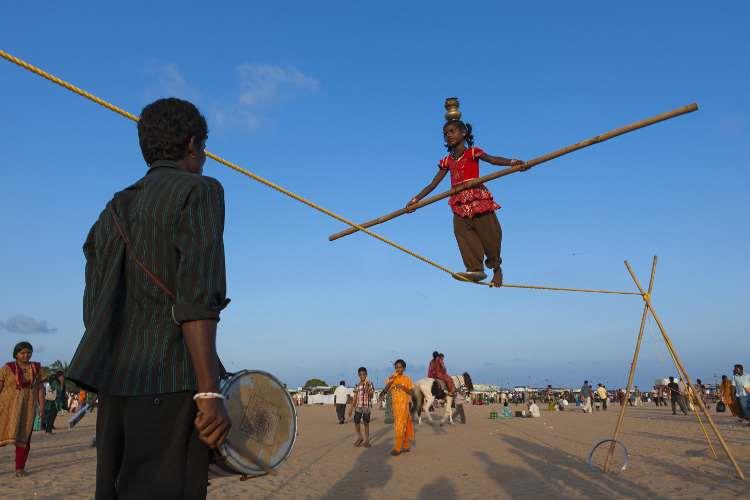
Acrobats at Marina Beach, Chennai. Image by Felix Hug / Getty Images.
November 8, 2014
At first glance, Chennai might not seem the obvious choice for a spot of meditation. With 4.7 million inhabitants and India’s biggest motor industry, the capital of Tamil Nadu is better known for noise and traffic jams than for moments of inner peace.

Acrobats at Marina Beach, Chennai. Image by Felix Hug / Getty Images.
But scratch the surface and you’ll soon discover that the self-proclaimed first city of South India has hidden depths of spirituality.
Known as Madras under the British, Chennai reverted to its Indian name in 1996, riding a surge of national pride that saw Bombay rebranded as Mumbai and Cochin rebranded as Kochi. However, hopes that the name change would propel Chennai up the rankings of Indian tourist destinations proved premature – with its lack of big-name sights, new arrivals continued to move on quickly to other, more laid-back parts of the South.
However, there are signs that things are beginning to change. The construction of the Chennai Metro Rail – India‘s first integrated mass transit network – is set to take the discomfort out of travelling through the crowded streets. In early 2015, travellers will suddenly be able to explore Chennai in air-conditioned comfort, providing an added incentive to see more of this complex, complicated metropolis. Now back to the spirituality…

Women mark out rangoli patterns in Mylapore. Image by Srinivasa Krishnan / Getty Images.
Attend an ashram, tour a temple or join the crowds for a temple parade
Did we mention that Chennai is awash with ashrams, temples and philosophical retreats? While it lacks the ancient ruins of Delhi or the movie locations of Mumbai, what Chennai has in abundance is deep thinkers. Over the centuries, the city has attracted a veritable who’s who of philosophers and spiritual leaders, from Gandhi to Swami Vivekananda. Even the globe-trotting apostle Thomas passed through on his mission to bring Christianity to India, before being fatally speared, according to local legend, on St Thomas Mount in Mylapore.
Visit during any of the city’s frenetic festivals and you’ll see Chennai’s spirituality on proud display as temple idols are paraded through the streets and pavements are painted in mesmerizing geometric patterns known as rangoli to bring good luck for the coming year. If you are intrigued by this little-known side to Tamil Nadu‘s capital, make time for the following enlightening experiences.

Paddling on Marina Beach, Chennai. Image by Alessandro Malatesta / CC BY-ND 2.0.
Have your fortune told on Marina Beach
Asia’s second longest urban beach provides Chennai with some essential breathing space. As the sun sets, locals gather at Marina Beach to promenade, fly kites, go paddling, meet the opposite sex, or just sit on the sand enjoying the cooling sea breezes. If you join the sitting contingent, you can expect a visit from a wandering fortune teller, who will be happy to predict that you will find the perfect partner, come top in your class and secure the perfect job overseas, for a fee. Keep an eye out for the ‘parrot astrologers’ who use trained parakeets to predict the future by picking cards.
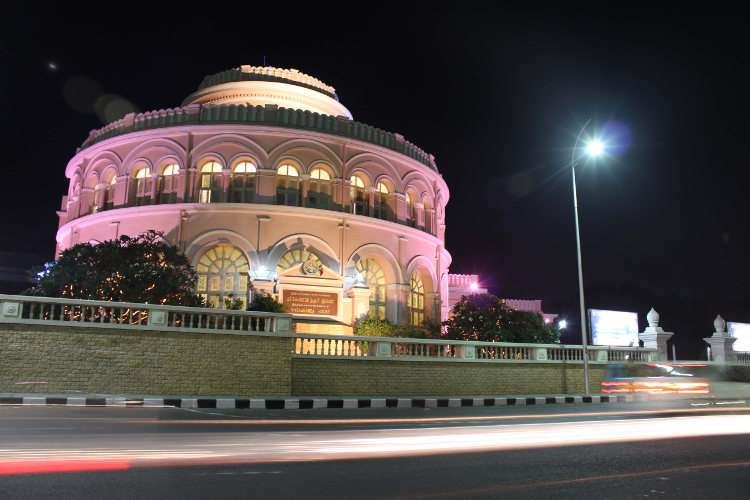
The Ice House at Vivekananda House. Image by Sridharan Chakravarthy / CC BY 2.0.
Chill out with a guru at Vivekananda House
When Swami Vivekananda came to Chennai in the 1890s, fresh from his ground-breaking tour of Britain and America, he chose the perfect spot to chill out – the city’s former Ice House, built in 1842 to store ice chipped from frozen lakes in New England and shipped to India in insulated tea clippers. The guru passed beyond this mortal plane in 1902, but the ashram founded in his name still offers weekly meditation classes in the hall next to the guru’s old quarters in Vivekananda House. Even if you don’t join the meditation sessions, it’s worth dropping in to see the building, which resembles something between a wedding cake and an English seaside pavilion.
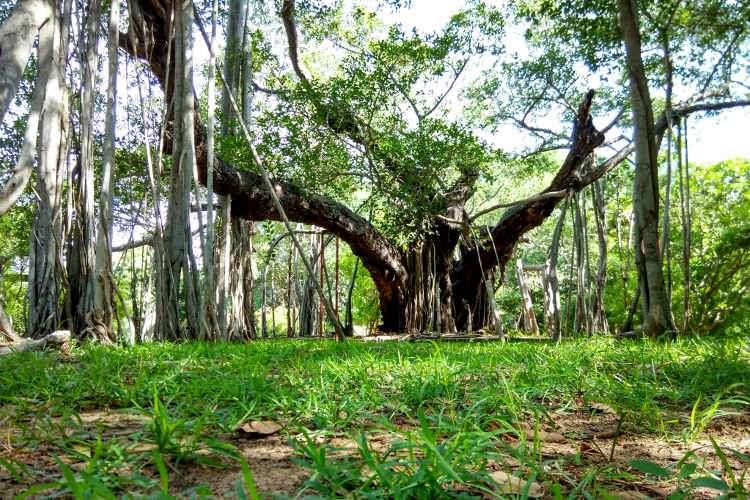
The famous banyan tree at Chennai's Theosophical Society. Image by Ram Karthik / CC BY 2.0.
Debate with a philosopher in the suburbs
A calm space for contemplation on the banks of the Adyar River, the Theosophical Society owes its existence to an eccentric Russian occultist, Helena Blavatsky, who became obsessed with the spiritualism of the east on a trip to India in the 1870s. Inspired by the teachings of eastern mystics, Blatavsky founded a new philosophical movement with the goal of forming ‘a nucleus of the Universal Brotherhood of Humanity, without distinction of race, creed, sex, caste, or color’. It was a noble ambition, and the centre she founded in the Chennai suburbs had a major influence on modern schools of Buddhist and Hindu thought. Visitors are free to browse the library, listen to debates and view the banyan tree in the grounds, said to be India’s largest.
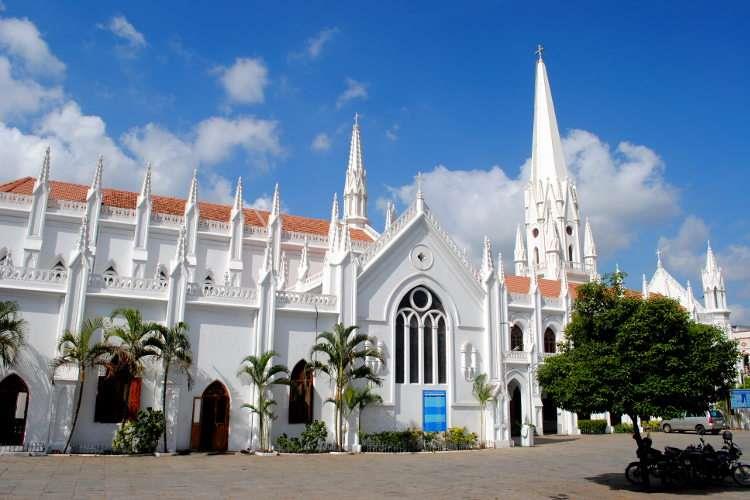
Façade of San Thome Cathedral, Mylapore. Image by Simon Antony / CC BY 2.0.
Visit an apostle at San Thome
Chennai might seem an unlikely destination for a Christian pilgrimage, but locals believe that the San Thome Cathedral, founded by the Portuguese in the 16th century, marks the final resting place of Thomas the Apostle, who travelled to India at the beginning of the Christian era on a mission to convert the Coromandel Coast. Most of the saint’s remains were whisked away to Italy in the 13th century, but the cathedral preserves a bone of St Thomas and the lance which allegedly impaled him in 72 AD. In fact, there are at least five other tombs of St Thomas dotted around the globe, but the Mylapore legend has a devoted following on the subcontinent. Out of interest, the current cathedral was rebuilt by the British in neo-Gothic style in 1893.
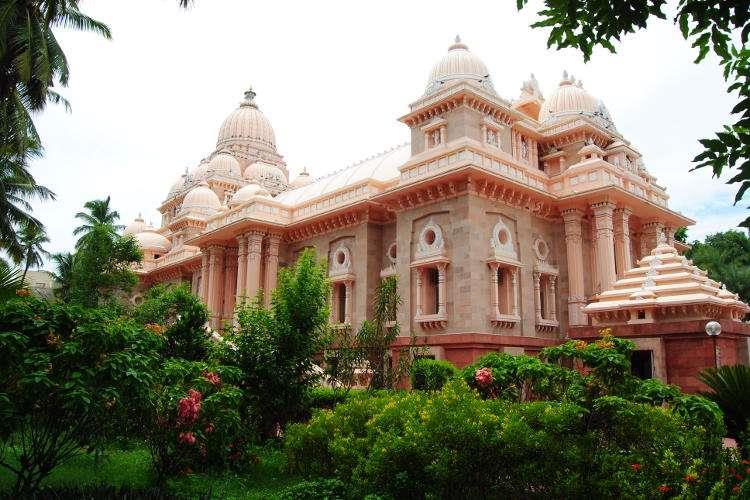
Domes of the Universal Temple at Sri Ramakrishna Math. Image by John Noble / Lonely Planet.
Rediscover the meaning of silence at Ramakrishna Math
When the noise and chaos become too much, retreat to the calm confines of the Sri Ramakrishna Math in Mylapore. Founded in honour of the 19th-century sage Sri Ramakrishna, this was the first ashram run by the Ramakrishna organisation in South India, and the handsome Universal Temple, which combines elements of Hindu, Jain and Buddhist architecture, is a popular spot for silent meditation. Take a moment to exhale and put the revving car engines, honking lorry horns and jangling rickshaw bells out of your mind…
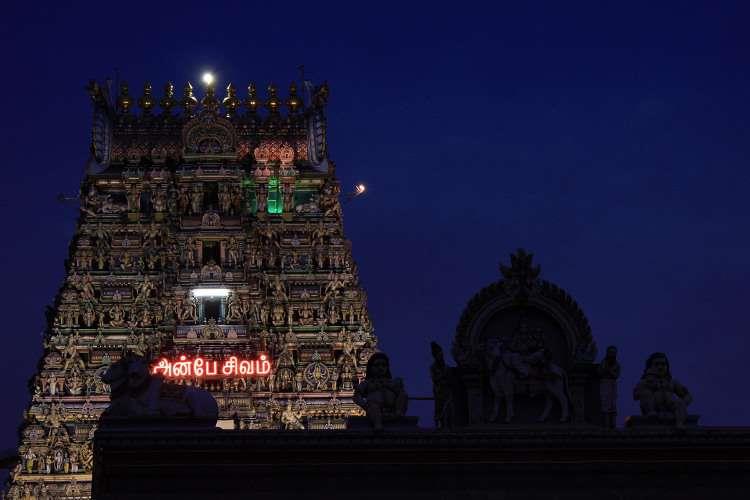
Gopurams after dark at the Kalapeeshwar Temple, Chennai. Image by Vinoth Chandar / CC BY 2.0.
Join the pilgrims at the peacock temple
Mylapore is also the setting for Chennai’s biggest and busiest Hindu temple. Flanked by rainbow-coloured gopurams (temple towers), the Kapaleeshwar Temple is founded on the spot where Shiva turned his wife into a peacock as a test of her devotion. Parvati meditated on the divinity of Shiva and was transformed back to her original form, inspiring a Hindu cult which constructed the first temple on this site in the 8th century. Kapaleeshwar is thronged by visitors for the annual Panguni Peruvizha festival in March or April, when the temple idols are paraded through the streets in a lavishly decorated wooden chariot. Feeding the teeming fish in the temple tank is an integral part of any visit to Kapaleeshwar; if you feel hungry yourself, there’s a branch of delicious vegetarian fastfood chain Saravana Bhavan just outside the temple compound.
Courtesy: Lonely Planet
















































































































